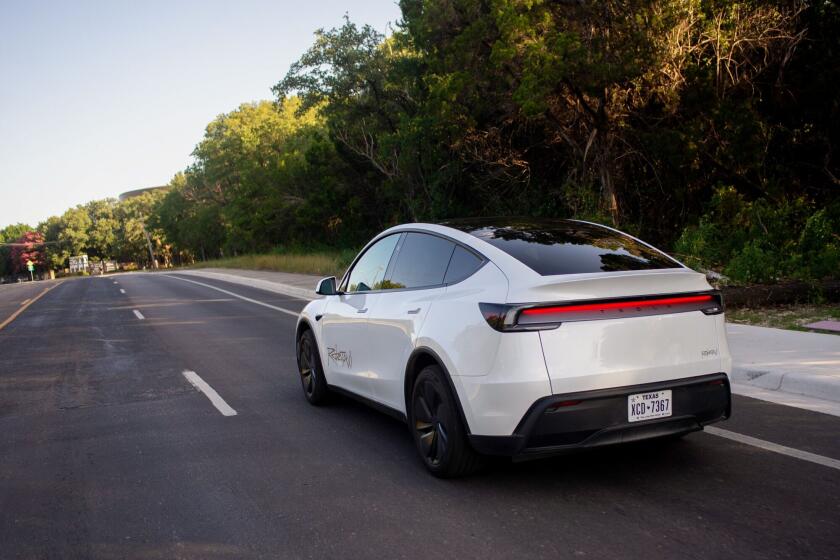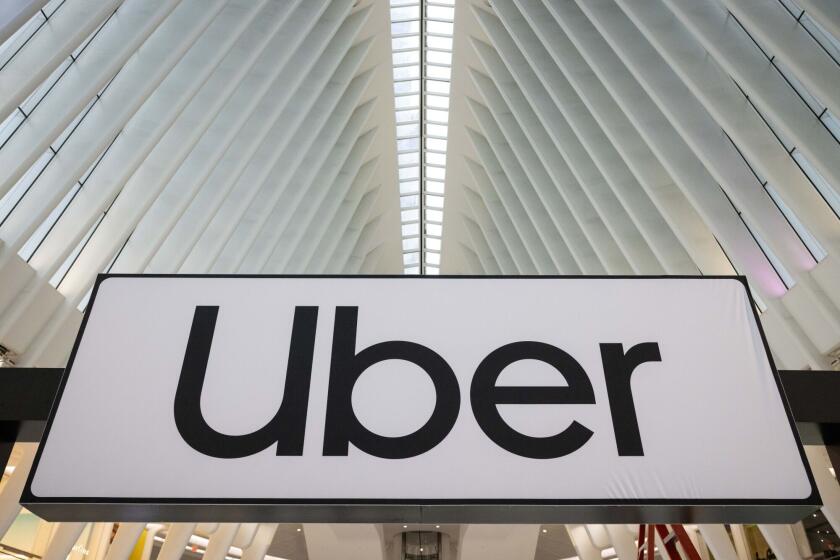County offers ‘inland port’ plan
- Share via
L.A. County officials on Wednesday unveiled plans for an “inland port” in the Antelope Valley -- a would-be hub more than 70 miles north of the ports of Los Angeles and Long Beach that is aimed at reducing heavy truck congestion throughout the region’s freeways.
The proposal comes as officials project a 400% increase in goods movement through the ports over the next 30 years, with transportation experts predicting that all those extra big rigs would further clog freeways.
Much of the cargo now is shipped by trucks on Southland freeways to warehouses and distribution facilities in the Inland Empire before it is distributed across the nation.
But L.A. County officials want a piece of that action and see the Antelope Valley, with large amounts of vacant land and potential rail access, as an ideal site.
The idea would be to transport cargo from the ports to Palmdale and Lancaster by rail, reducing reliance on big rigs.
“The inland port is a necessity if we’re not going to choke in congestion in the Los Angeles Basin,” said Los Angeles County Supervisor Michael Antonovich, who convened Wednesday’s meeting in downtown L.A. with officials representing transit agencies, the ports, railroads and businesses. “The congestion is here and it’s only going to get worse. We need to act now to resolve the problem.”
But many challenges face planners.
The fast-growing Antelope Valley suffers from what officials agree is a lack of transportation infrastructure. The existing rail lines are already near capacity, meaning new lines would have to be built to serve the inland port. Moreover, only one freeway -- the clogged 14 Freeway -- connects the valley to the L.A. Basin.
The inland port idea gained attention in recent months after voters in 2006 passed a $19.9-billion statewide transportation bond measure, $3.2 billion of which was allocated for projects to improve the movement of goods through ports and on highways and rail. L.A. County officials are angling for a cut of the money.
The interest also comes as officials have been promoting the development of Palmdale Regional Airport, which could serve as a facility to ship air freight, and as officials have been studying construction of a new freeway or toll road that would connect Lancaster and Palmdale west to the 5 Freeway and east to the 15 Freeway in San Bernardino County.
Inland ports are not a new concept. With land near seaports costly and scarce, other ports around the country have looked inland to develop space for warehouse and distribution facilities and a hub to transport goods by truck, rail car or airplane.
Hasan Ikhrata, director of planning and policy for the Southern California Assn. of Governments, said that developing an inland port would be critical to the region’s future.
“There is no land to expand the port facilities,” Ikhrata said. “You need at least 500 acres for a decent inland port facility, and that kind of land is not available in the urban core.”
The ports of Los Angeles and Long Beach handle one-third of all waterborne freight-container traffic in the U.S., and 50% to 70% of that cargo is headed for delivery outside of Southern California, according to the Southern California Assn. of Governments.
How the ports of Los Angeles and Long Beach deal with the projected rise in commerce traffic will play a key role in how Southern California deals with increased freeway congestion. Trucks now use 30% to 40% of freeway capacity.
The region’s major freeways, such as the 5,10, 60 and 710, are often congested with trucks, creating a hazard for motorists.
“Goods movement is really a challenge to us, both because of the congestion it causes, and then the health issues: We have the worst air quality in the country,” said Roger Snoble, chief executive of the Los Angeles County Metropolitan Transportation Authority.
Planning for the inland port concept is still in early stages; officials haven’t projected how much it would cost or who would pay to build it.
One idea involves a public-private partnership similar to the authority that built the 20-mile Alameda Corridor, a $2.5-billion below-ground express rail line opened in 2002 that runs mostly in a trench from the ports to downtown L.A.
Such a partnership could, for example, have railroad companies invest in upgrading or building new lines, and shipping companies building warehouses in the inland port.
But it’s clear that the inland port would require significant changes:
* Roads. Local officials say they desperately need more funds to upgrade their roads, and have discussed ideas such as drilling a tunnel through the San Gabriel Mountains to build a second route. “What we need out of Los Angeles is support -- financial support,” said Palmdale Mayor James C. Ledford Jr. “If you expect the high desert to accept the growth, you’ve got to give us more tools to accommodate the growth.”
* Rail lines: Railroad companies have struggled to compete with truckers for short-haul routes. Trains have the additional costs of loading and unloading cars, as well as paying a truck to haul cargo from the train depot to a final warehouse destination.
* Logistics: Officials would need a plan to avoid backtracking. A significant amount of cargo coming in through the two ports stays in Southern California, and officials fear unnecessary congestion if cargo is transported to the inland port on trains, only to be redistributed to trucks that would need to ship it back to the Los Angeles area.
An inland port could also increase pollution levels and congestion in the Antelope Valley, which the U.S. Census reaffirmed last month as one of the fastest-growing communities in the country.
Lancaster Mayor Henry W. Hearns acknowledged those concerns, but added that growth in the Antelope Valley is inevitable, and the region stands to benefit from the inland port idea.
“It’s going to raise our economic status; it’s going to bring jobs,” Hearns said.
Several officials, however, stressed the importance of further study before going forward with the plan.
“It’s very important to look at the transportation infrastructure and make sure the site will work,” said Thad Brundrett, a land development expert who spoke at Wednesday’s meeting. “You can’t just go out and build the facility, and hope someone will show up.”
--
More to Read
Sign up for Essential California
The most important California stories and recommendations in your inbox every morning.
You may occasionally receive promotional content from the Los Angeles Times.














